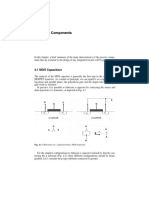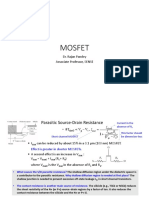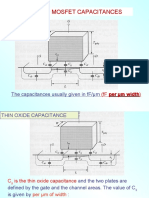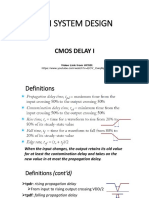Professional Documents
Culture Documents
8 Cmos Capacitance
8 Cmos Capacitance
Uploaded by
api-3864016Original Description:
Copyright
Available Formats
Share this document
Did you find this document useful?
Is this content inappropriate?
Report this DocumentCopyright:
Available Formats
8 Cmos Capacitance
8 Cmos Capacitance
Uploaded by
api-3864016Copyright:
Available Formats
CMOS Capacitance Estimation
VLSI Design Dr. Bassel Soudan – University of Sharjah 1
MOS Transistor Capacitance
• Any two conductors separated by an insulator
have capacitance
• Gate to channel capacitor is very important
– Creates channel charge necessary for operation
• Source and drain have capacitance to body
– Across reverse-biased diodes
– Called diffusion capacitance because
it is associated with source/drain diffusion
VLSI Design Dr. Bassel Soudan – University of Sharjah 2
MOS Transistor Capacitance
Gate Gate
Source Drain Source Drain
CGS CGD CGS CGD
CGB CGB
CSB CDB CSB CDB
VDD
VLSI Design Dr. Bassel Soudan – University of Sharjah 3
Gate Capacitance
ε OX WL
CGB = = COX WL
tOX
• Define Cpermicron = CoxL
– Typically about 2 fF/µm
• Therefore, CGB = Cpermicron X W
• Realistically, there are additional capacitances.
However, the above
relationship is a
polysilicon
good approximation gate
W
of the gate
t ox
capacitance. L SiO 2
gate oxide
n+ n+ (good insulator, εox = 3.9ε0)
p-type body
VLSI Design Dr. Bassel Soudan – University of Sharjah 4
Diffusion Capacitance
• CSB, CDB
• Undesirable, called parasitic capacitance
• Capacitance depends on area and perimeter
– Comparable to CG for
contacted diffusion
– ½ CG for uncontacted
– Varies with process
VLSI Design Dr. Bassel Soudan – University of Sharjah 5
MOSFET Resistance
• The resistance of a MOSFET transistor must be
determined from the Shockley I-V relationships.
– However, Ids(Vds, Vgs).
– Therefore, R – the resistance to current moving
from the drain to the source is:
−1
⎛ ∂I ⎞
R = ⎜⎜ ds ⎟⎟
⎝ ∂Vds ⎠
• However,
– Shockley models for MOSFET transistor are not
accurate enough for modern transistors
– Too complicated for hand analysis
VLSI Design Dr. Bassel Soudan – University of Sharjah 6
Effective Resistance
• Simplification: treat transistor as resistor
– Replace with effective resistance R
• Ids = Vds/R
– R averaged across switching range of digital gate
• Simulate the transistor driving a known capacitance and
measure the time constant.
• Too inaccurate to predict current at any given time
– But good enough to predict RC delay
VLSI Design Dr. Bassel Soudan – University of Sharjah 7
RC Delay Model
• Use equivalent circuits for MOS transistors
– Ideal switch + capacitances and ON resistance
– Unit nMOS has resistance R, capacitance C
– Unit pMOS has resistance 2R, capacitance C
• The PMOS resistance should actually be (k’n/k’p)R
• Capacitance proportional to width
• Resistance inversely proportional to width
d
s
kC
kC
R/k
d 2R/k
s
g k g kC
g k g
s kC kC
kC d
s
d
VLSI Design Dr. Bassel Soudan – University of Sharjah 8
RC Values
• Capacitance
– C = Cg = Cs = Cd = 2 fF/µm of gate width
– Values similar across many processes
• Resistance
– R ≈ 6 KΩ*µm in 0.6um process
– Improves with shorter channel lengths
• Unit transistors
– May refer to minimum contacted device (4/2 λ)
– Or maybe 1 µm wide device
– Doesn’t matter as long as you are consistent
VLSI Design Dr. Bassel Soudan – University of Sharjah 9
Input Capacitance of the CMOS Inverter
• The input capacitance of the CMOS inverter can
be written as:
– Cin = CGN + CGP = (WN + WP) Cpermicron
– Cpermicron = COX X L:
• COX – the oxide capacitance which depends on the type
of oxide used and is inversely dependent on the
thickness of the oxide layer.
– COX is typically in the range of ~700aF/µm2
» a stands for atto – 10-18.
• L – the length of the channel.
VLSI Design Dr. Bassel Soudan – University of Sharjah 10
Example
• Calculate the input capacitance for a CMOS
inverter with the following characteristics:
– COX = 690 aF/µm2
– WN / LN = 4µm / 2µm
– WP / LP = 8µm / 2µm
Using the expressions from above:
Cin = (WN + WP) Cpermicron
Cpermicron = L COX
Cpermicron = 2µm X 690 aF/µm2 = 1.38 fF/µm
Cin = (4µm + 8µm) X 1.38 fF/µm
Cin = 16.56 fF
VLSI Design Dr. Bassel Soudan – University of Sharjah 11
Inverter Delay Estimate
• Estimate the delay of a fanout-of-1 inverter
2 Y 2
A
1 1
VLSI Design Dr. Bassel Soudan – University of Sharjah 12
Inverter Delay Estimate
• Estimate the delay of a fanout-of-1 inverter
2C
2C
2C
2 Y 2
A Y
1 1
C
R C
VLSI Design Dr. Bassel Soudan – University of Sharjah 13
Inverter Delay Estimate
• Estimate the delay of a fanout-of-1 inverter
2C
2C 2C
2C 2C
2 Y 2
A Y
1 1 R C
C
R C C
VLSI Design Dr. Bassel Soudan – University of Sharjah 14
Inverter Delay Estimate
• Estimate the delay of a fanout-of-1 inverter
2C
2C 2C
2C 2C
2 Y 2
A Y
1 1 R C
C
R C C
d = 6RC
VLSI Design Dr. Bassel Soudan – University of Sharjah 15
Delay Components
• Delay has two parts
– Parasitic delay – due to capacitances of the
driving gate itself.
• 3 RC in the inverter example above.
• Independent of load.
– Effort delay – due to capacitances of the load
gates.
• The other 3 RC in the inverter example above.
• Depends on the number and type of driven gates.
VLSI Design Dr. Bassel Soudan – University of Sharjah 16
Example: 3-input NAND
• Sketch a 3-input NAND with transistor widths
chosen to achieve effective rise and fall
resistances equal to a unit inverter (R).
VLSI Design Dr. Bassel Soudan – University of Sharjah 17
Example: 3-input NAND
• Sketch a 3-input NAND with transistor widths
chosen to achieve effective rise and fall
resistances equal to a unit inverter (R).
VLSI Design Dr. Bassel Soudan – University of Sharjah 18
Ex.: Capacitances of a 3-input NAND
• Determine the parasitic capacitances of a 3-input
NAND with transistor widths chosen to achieve
effective rise and fall resistances equal to a unit
inverter (R).
2 2 2
3
3
3
VLSI Design Dr. Bassel Soudan – University of Sharjah 19
3-input NAND Caps
• Annotate the 3-input NAND gate with gate and
diffusion capacitance.
2 2 2
VLSI Design Dr. Bassel Soudan – University of Sharjah 20
3-input NAND Caps
• Annotate the 3-input NAND gate with gate and
diffusion capacitance.
2C 2C 2C
2C 2C 2C
2 2 2
2C 2C 2C
3C
3
3C
3C
3
3C
3C
3
3C
3C
VLSI Design Dr. Bassel Soudan – University of Sharjah 21
Combining Capacitances
• Capacitors on source diffusions of transistors
connected to VDD or GND will be shorted out.
• The DC voltage on the second terminal of a
capacitor is irrelevant to delay calculation.
– Therefore, all capacitors will be estimated as
terminating to GND.
• Combine parallel and series capacitances in the
normal manner.
VLSI Design Dr. Bassel Soudan – University of Sharjah 22
3-input NAND Caps
• Annotate the 3-input NAND gate with gate and
diffusion capacitance.
2 2 2
3 9C
5C
3 3C
5C
3 3C
5C
VLSI Design Dr. Bassel Soudan – University of Sharjah 23
Elmore Delay
• ON transistors look like resistors
• Pullup or pulldown network modeled as RC
ladder
• Elmore delay of RC ladder
t pd ≈ ∑
nodes i
Ri −to − sourceCi
= R1C1 + ( R1 + R2 ) C2 + ... + ( R1 + R2 + ... + RN ) C N
R1 R2 R3 RN
C1 C2 C3 CN
VLSI Design Dr. Bassel Soudan – University of Sharjah 24
Example: 2-input NAND
• Estimate worst-case rising and falling delay of 2-
input NAND driving h identical gates.
2 2 Y
h copies
A 2
B 2x
VLSI Design Dr. Bassel Soudan – University of Sharjah 25
Example: 2-input NAND
• Estimate rising and falling propagation delays of
a 2-input NAND driving h identical gates.
2 2 Y
A 2 6C 4hC h copies
B 2x 2C
VLSI Design Dr. Bassel Soudan – University of Sharjah 26
Example: 2-input NAND
• Estimate rising and falling propagation delays of
a 2-input NAND driving h identical gates.
2 2 Y
A 2 6C 4hC h copies
B 2x 2C
R
Y t pdr = ( 6 + 4h ) RC
(6+4h)C
VLSI Design Dr. Bassel Soudan – University of Sharjah 27
Example: 2-input NAND
• Estimate rising and falling propagation delays of
a 2-input NAND driving h identical gates.
2 2 Y
A 2 6C 4hC h copies
B 2x 2C
VLSI Design Dr. Bassel Soudan – University of Sharjah 28
Example: 2-input NAND
• Estimate rising and falling propagation delays of
a 2-input NAND driving h identical gates.
2 2 Y
A 2 6C 4hC h copies
B 2x 2C
x R/2 t pdf = ( 2C ) ( R2 ) + ⎡⎣( 6 + 4h ) C ⎤⎦ ( R2 + R2 )
Y
= ( 7 + 4h ) RC
R/2 2C (6+4h)C
VLSI Design Dr. Bassel Soudan – University of Sharjah 29
Diffusion Capacitance
• we assumed contacted diffusion on every s / d.
• Good layout minimizes diffusion area
• Ex: NAND3 layout shares one diffusion contact
– Reduces output capacitance by 2C
– Merged uncontacted diffusion might help too
2C 2C
Shared
Contacted
Diffusion Isolated
Contacted 2 2 2
Merged Diffusion
Uncontacted 3 7C
Diffusion 3 3C
3C 3C 3C 3 3C
VLSI Design Dr. Bassel Soudan – University of Sharjah 30
Layout Comparison
• Which layout is better?
VDD VDD
A B A B
Y Y
GND GND
VLSI Design Dr. Bassel Soudan – University of Sharjah 31
Determining the Total Delay for a Circuit
• In order to determine the total delay for a circuit,
one has to determine the delay of each stage
and then calculate the total delay for all stages
combined.
– Two delays: rising and falling.
• Example, using Elmore Delay Model, determine
the total delay of the following circuit:
IN
OUT
12 C
VLSI Design Dr. Bassel Soudan – University of Sharjah 32
Determine Transistor Sizes
P: 2
IN N: 1 P: 2 P: 2
N: 2 N: 1 P: 4
OUT
N: 1
12 C
P: 2
N: 3
P: 2
N: 1
VLSI Design Dr. Bassel Soudan – University of Sharjah 33
Assume Logic Transition
PUN PUN
P: 2
IN N: 1 P: 2 P: 2
N: 2 N: 1 P: 4
1 OUT
PDN 0 N: 1
PDN
12 C
P: 2
N: 3
P: 2
N: 1
VLSI Design Dr. Bassel Soudan – University of Sharjah 34
Determine Individual Stage Delays
PUN PUN
P: 2
IN N: 1 P: 2 P: 2
N: 2 N: 1 P: 4
1 OUT
PDN 0 N: 1
PDN
12 C
P: 2
N: 3
P: 2
N: 1
R 3C 4(4C)
d = 19RC
VLSI Design Dr. Bassel Soudan – University of Sharjah 35
Determine Individual Stage Delays
PUN PUN
IN P: 2
N: 1 P: 2 P: 2
N: 2 N: 1 P: 4 OUT
1
PDN 0 N: 1
PDN
12 C
P: 2
N: 3
P: 2
N: 1
R 6C 3C
d = 9RC
VLSI Design Dr. Bassel Soudan – University of Sharjah 36
Determine Individual Stage Delays
PUN PUN
IN P: 2
N: 1 P: 2 P: 2
N: 2 N: 1 P: 4 OUT
1
PDN 0 N: 1
PDN
12 C
P: 2
N: 3
P: 2
N: 1
R 3C 5C + 5C + 3C = 13C
d = 16RC
VLSI Design Dr. Bassel Soudan – University of Sharjah 37
Determine Individual Stage Delays
PUN PUN
IN P: 2
N: 1 P: 2 P: 2
N: 2 N: 1 P: 4 OUT
1
PDN 0 N: 1
PDN
12 C
P: 2
N: 3
P: 2
N: 1
R/2
R/2 4C 6C 12C
d = (R/2)4C + (R/2 + R/2) (6C + 12C) = 20RC
VLSI Design Dr. Bassel Soudan – University of Sharjah 38
Total Rising Output Delay
PUN PUN
P: 2
IN N: 1 P: 2 P: 2
N: 2 N: 1 P: 4
1 OUT
PDN 0 N: 1
PDN
12 C
P: 2
N: 3
P: 2
N: 1
Tpdr = 19RC + 9RC + 16RC + 20RC = 64RC
VLSI Design Dr. Bassel Soudan – University of Sharjah 39
Other Logic Transition
PDN PDN
P: 2
IN N: 1 P: 2 P: 2
N: 2 N: 1 P: 4
1 OUT
PUN 0 N: 1
PUN
12 C
P: 2
N: 3
P: 2
N: 1
VLSI Design Dr. Bassel Soudan – University of Sharjah 40
Determine Individual Stage Delays
PDN PDN
P: 2
IN N: 1 P: 2 P: 2
N: 2 N: 1 P: 4
1 OUT
PUN 0 N: 1
PUN
12 C
P: 2
N: 3
P: 2
N: 1
R 3C 4(4C)
d = 19RC
VLSI Design Dr. Bassel Soudan – University of Sharjah 41
Determine Individual Stage Delays
PDN PDN
IN P: 2
N: 1 P: 2 P: 2
N: 2 N: 1 P: 4 OUT
1
PUN 0 N: 1
PUN
12 C
P: 2
N: 3
P: 2
N: 1
R/2
R/2 2C 6C 3C
d = (R/2)2C + (R/2 + R/2) (6C + 3C) = 10RC
VLSI Design Dr. Bassel Soudan – University of Sharjah 42
Determine Individual Stage Delays
PDN PDN
IN P: 2
N: 1 P: 2 P: 2
N: 2 N: 1 P: 4 OUT
1
PUN 0 N: 1
PUN
12 C
P: 2
N: 3
P: 2
N: 1
R 3C 5C + 5C + 3C = 13C
d = 16RC
VLSI Design Dr. Bassel Soudan – University of Sharjah 43
Determine Individual Stage Delays
PDN PDN
IN P: 2
N: 1 P: 2 P: 2
N: 2 N: 1 P: 4 OUT
1
PUN 0 N: 1
PUN
12 C
P: 2
N: 3
P: 2
N: 1
R 6C 12C
d = 18RC
VLSI Design Dr. Bassel Soudan – University of Sharjah 44
Total Falling Output Delay
PDN PDN
P: 2
IN N: 1 P: 2 P: 2
N: 2 N: 1 P: 4
1 OUT
PUN 0 N: 1
PUN
12 C
P: 2
N: 3
P: 2
N: 1
Tpdf = 19RC + 10RC + 16RC + 18RC = 63RC
VLSI Design Dr. Bassel Soudan – University of Sharjah 45
You might also like
- EE16B HW 1 SolutionsDocument13 pagesEE16B HW 1 SolutionsSummer YangNo ratings yet
- CMOS Digital Integrated CircuitsDocument405 pagesCMOS Digital Integrated CircuitsAmr Yassin100% (1)
- Cmos ThesisDocument144 pagesCmos ThesisSumit Attri100% (2)
- Chap2 Lect06 RC ModelDocument11 pagesChap2 Lect06 RC ModeldkishoreNo ratings yet
- Pseudo Nmos PDFDocument22 pagesPseudo Nmos PDFAnonymous hsb1qnt3B0% (1)
- Characteristics of Digital IC's:-Voltage and Current Parameters Fan-Out Noise Margin Propagation Delay (Speed of Operation) Power Dissipation Operating TemperatureDocument48 pagesCharacteristics of Digital IC's:-Voltage and Current Parameters Fan-Out Noise Margin Propagation Delay (Speed of Operation) Power Dissipation Operating TemperaturesushmanalavadeNo ratings yet
- Lecture9 MOS Transistor DynamicsDocument60 pagesLecture9 MOS Transistor DynamicsvenkateshNo ratings yet
- The Devices:: MOS Transistor DynamicsDocument60 pagesThe Devices:: MOS Transistor Dynamicsअसीम मेहताNo ratings yet
- Mos CapacitancesDocument26 pagesMos CapacitancesAbhishek SinghNo ratings yet
- 2023 Ch4-Elmore DelayDocument38 pages2023 Ch4-Elmore DelayAn NguyenNo ratings yet
- MOSFET-Internal Capacitances PDFDocument11 pagesMOSFET-Internal Capacitances PDFJayanth Sriranga100% (2)
- Frequency Response of Mosfet The Expanded Hybrid Equivalent Circuit of The Bipolar Transistor High-Frequency ResponseDocument37 pagesFrequency Response of Mosfet The Expanded Hybrid Equivalent Circuit of The Bipolar Transistor High-Frequency ResponseMuthukrishnan Vijayan VijayanNo ratings yet
- L3 (Part A) - MOS Oxide CapDocument19 pagesL3 (Part A) - MOS Oxide CapSambhav GullaNo ratings yet
- Module2 - Capacitor and Resistor ModelDocument37 pagesModule2 - Capacitor and Resistor Modeldilshan singhNo ratings yet
- L1 - MOS Junction CapDocument28 pagesL1 - MOS Junction CapRaghu RamanNo ratings yet
- WINSEM2022-23 ECE3002 ETH VL2022230500996 Reference Material I 20-01-2023 Lecture4Document44 pagesWINSEM2022-23 ECE3002 ETH VL2022230500996 Reference Material I 20-01-2023 Lecture4sanjeev dhayalanNo ratings yet
- Common Collector (CC) or Emitter FollowerDocument49 pagesCommon Collector (CC) or Emitter Followerwarumwas41No ratings yet
- Cs AmplifierDocument129 pagesCs AmplifierjisooNo ratings yet
- 2023 Ch4-Elmore DelayDocument38 pages2023 Ch4-Elmore DelayĐạt NguyễnNo ratings yet
- CH 04 Delay Part 01Document25 pagesCH 04 Delay Part 01muneeb.abrarNo ratings yet
- Circuit Characterization and Performance Estimation: Instructor Dr. İsmail Enis UnganDocument36 pagesCircuit Characterization and Performance Estimation: Instructor Dr. İsmail Enis UnganyousufnetNo ratings yet
- Lect 14 Diff PairDocument23 pagesLect 14 Diff PairNguyen HienNo ratings yet
- MOS Transistor Theory: - So Far, We Have Viewed A MOS Transistor As An Ideal Switch (Digital Operation)Document36 pagesMOS Transistor Theory: - So Far, We Have Viewed A MOS Transistor As An Ideal Switch (Digital Operation)maniroopNo ratings yet
- EC4068D-Analog MOS Integrated Circuits Dhanaraj K. J. Associate Professor ECED, NIT CalicutDocument12 pagesEC4068D-Analog MOS Integrated Circuits Dhanaraj K. J. Associate Professor ECED, NIT CalicutM KIRITI SAI KUMARNo ratings yet
- VLSI Ch4 DelayDocument27 pagesVLSI Ch4 Delayជើងកាង ភូមិNo ratings yet
- MOS CapacitanceDocument19 pagesMOS CapacitanceSandeep LocharlaNo ratings yet
- W HK HQG Yi Up UEp NCBDocument4 pagesW HK HQG Yi Up UEp NCBpayam79bNo ratings yet
- 3450 1 PDFDocument20 pages3450 1 PDFKen WalkerNo ratings yet
- Lecture07 Capacitance ResistanceDocument44 pagesLecture07 Capacitance ResistanceMd MianNo ratings yet
- MOSCAPDocument6 pagesMOSCAPEjder YildizNo ratings yet
- Kelompok 4 Bab 4Document81 pagesKelompok 4 Bab 4Wisnu WicaksonoNo ratings yet
- Notes 2Document59 pagesNotes 2Muhammed Bekir AdamNo ratings yet
- Unit 4 Basic Circuit Design ConceptsDocument43 pagesUnit 4 Basic Circuit Design Conceptsmonisa kannanNo ratings yet
- Thin Film DepositionDocument23 pagesThin Film Depositionsudha mallikNo ratings yet
- 24 - Capacitance and Dielectrics - R K ParidaDocument12 pages24 - Capacitance and Dielectrics - R K ParidaMonicaNo ratings yet
- Vlsi Unit 4Document100 pagesVlsi Unit 4SRHNo ratings yet
- MOSFET CapacitancesDocument19 pagesMOSFET CapacitancesAnushkaNo ratings yet
- Logic Gate Delay Modeling - 1: Bishnu Prasad Das Research Scholar Cedt, Iisc, Bangalore Bpdas@Cedt - Iisc.Ernet - inDocument45 pagesLogic Gate Delay Modeling - 1: Bishnu Prasad Das Research Scholar Cedt, Iisc, Bangalore Bpdas@Cedt - Iisc.Ernet - inDevendra GoswamiNo ratings yet
- Pn-Junction: Excess Minority Carrier Charge Space ChargeDocument28 pagesPn-Junction: Excess Minority Carrier Charge Space ChargePrashant Kumar SinghNo ratings yet
- Ee6471 wk5Document56 pagesEe6471 wk5Murthy MvsNo ratings yet
- 2017 Ch4-DelayDocument25 pages2017 Ch4-DelayTrung NguyênNo ratings yet
- Mosfet CapacitancesDocument17 pagesMosfet Capacitancesbhvkch2n0389100% (1)
- Lecture 02 UploadDocument18 pagesLecture 02 UploadLanku J GowdaNo ratings yet
- FALLSEM2019-20 ECE5018 TH VL2019201007688 Reference Material I 22-Oct-2019 MOSFET-5 2 PDFDocument16 pagesFALLSEM2019-20 ECE5018 TH VL2019201007688 Reference Material I 22-Oct-2019 MOSFET-5 2 PDFAnonymous ptSFzcfNo ratings yet
- Delay Time Estimation in Digital DesignDocument12 pagesDelay Time Estimation in Digital DesignSandeep PaulNo ratings yet
- Dual-Gate Lateral Double-Diffused Metal&ndash Oxide Semiconductor With Ultra-Low Specific On-ResistanceDocument6 pagesDual-Gate Lateral Double-Diffused Metal&ndash Oxide Semiconductor With Ultra-Low Specific On-ResistanceAnonymous G1iPoNOKNo ratings yet
- Chapter 2Document14 pagesChapter 2sanchariguha1996No ratings yet
- Lec10 Diode ACDocument24 pagesLec10 Diode ACMurali DharanNo ratings yet
- VLSIDocument140 pagesVLSINiranjan ReddyNo ratings yet
- Lecture11 MOS Cap Delay 6upDocument6 pagesLecture11 MOS Cap Delay 6upNaveen KuramNo ratings yet
- Review of Mosfet Capacitances: The Capacitances Usually Given in FF/ MDocument46 pagesReview of Mosfet Capacitances: The Capacitances Usually Given in FF/ MSalim SanNo ratings yet
- Cmos Digital Vlsi Design: Mos Transistor Basics - IDocument22 pagesCmos Digital Vlsi Design: Mos Transistor Basics - Ikanchimi reddy RaginiNo ratings yet
- Gopi Krishna Saramekala Assistant Professor: National Institute of Technology CalicutDocument56 pagesGopi Krishna Saramekala Assistant Professor: National Institute of Technology Calicutarjun raghavan.vNo ratings yet
- mOS PDFDocument48 pagesmOS PDFDebasish KerrNo ratings yet
- MOS Transistor Theory: Slides Adapted From: N. Weste, D. Harris, CMOS VLSI Design,, 3/e, 2004Document48 pagesMOS Transistor Theory: Slides Adapted From: N. Weste, D. Harris, CMOS VLSI Design,, 3/e, 2004Debasish KerrNo ratings yet
- Design and Implementation of VLSI SystemsDocument55 pagesDesign and Implementation of VLSI SystemsLê Bá Phước LongNo ratings yet
- Deep-Level Transient SpectrosDocument9 pagesDeep-Level Transient SpectrosJohn AlexisNo ratings yet
- EC4068D-Analog MOS Integrated Circuits Dhanaraj K. J. Associate Professor ECED, NIT CalicutDocument11 pagesEC4068D-Analog MOS Integrated Circuits Dhanaraj K. J. Associate Professor ECED, NIT CalicutM KIRITI SAI KUMARNo ratings yet
- Cable SizingDocument29 pagesCable SizingAutomation RaazNo ratings yet
- Harmonics PDFDocument31 pagesHarmonics PDFralphholingsheadNo ratings yet
- Lecture 21Document20 pagesLecture 21zentillNo ratings yet
- Chapter 6 CapacitanceDocument23 pagesChapter 6 Capacitanceahmad abufaresNo ratings yet
- Lecture 9 - CMOS Delay IDocument28 pagesLecture 9 - CMOS Delay IWambi DanielcollinsNo ratings yet
- Charge-Based MOS Transistor Modeling: The EKV Model for Low-Power and RF IC DesignFrom EverandCharge-Based MOS Transistor Modeling: The EKV Model for Low-Power and RF IC DesignNo ratings yet
- Modelling TypesDocument9 pagesModelling Typesapi-3864016No ratings yet
- MODELTYPDocument11 pagesMODELTYPapi-3864016No ratings yet
- Intro 2Document23 pagesIntro 2api-3864016No ratings yet
- Assignment 4Document1 pageAssignment 4api-3864016No ratings yet
- Intro 1Document8 pagesIntro 1api-3864016No ratings yet
- VHDLDocument97 pagesVHDLapi-3864016100% (1)
- Assignment 2Document1 pageAssignment 2api-3864016No ratings yet
- Assignment 3Document1 pageAssignment 3api-3864016No ratings yet
- 9 Cmos Timing CharDocument7 pages9 Cmos Timing Charapi-3864016No ratings yet
- Assignment 1Document1 pageAssignment 1api-3864016No ratings yet
- Siri MsDocument40 pagesSiri Msapi-3864016No ratings yet
- Lec 18 Low PowerDocument24 pagesLec 18 Low Powerapi-3864016No ratings yet
- Topic 3Document48 pagesTopic 3Saiful NizamNo ratings yet
- MOSFETDocument23 pagesMOSFETRahulKushwahaNo ratings yet
- CMOS IntroDocument39 pagesCMOS IntrovenkateshNo ratings yet
- Design and Performance Analysis of An Ultra-Low Voltage (VDD) CMOS Ring Oscillator IEEE 2019Document10 pagesDesign and Performance Analysis of An Ultra-Low Voltage (VDD) CMOS Ring Oscillator IEEE 2019Mary Jane MalibiranNo ratings yet
- Cad Lab Cmos Inverter PDFDocument4 pagesCad Lab Cmos Inverter PDFpcjoshi02No ratings yet
- Cmos Inverter CharacteristicsDocument8 pagesCmos Inverter CharacteristicsShambhavi SonuNo ratings yet
- Internship Report 2018 (Repaired) (Repaired) (Repaired)Document69 pagesInternship Report 2018 (Repaired) (Repaired) (Repaired)Anupama venkateshNo ratings yet
- Complementary Metal-Oxide-Semiconductor (CMOS) (PronouncedDocument3 pagesComplementary Metal-Oxide-Semiconductor (CMOS) (PronouncedMeiling MizukiNo ratings yet
- A Low Power Schmitt Trigger Design Using SBT Technique in 180nm CMOS TechnologyDocument4 pagesA Low Power Schmitt Trigger Design Using SBT Technique in 180nm CMOS TechnologySowmya ReddyNo ratings yet
- Agenda: Body Effect Model Reverse and Forward Body BiasDocument6 pagesAgenda: Body Effect Model Reverse and Forward Body Biashamsa gNo ratings yet
- Design & Analysis of Dynamic Comparators With Offset CalibrationDocument65 pagesDesign & Analysis of Dynamic Comparators With Offset CalibrationSupriyo SrimaniNo ratings yet
- Microwind3.1 Design Rules For 45NM Cmos TechnologyDocument44 pagesMicrowind3.1 Design Rules For 45NM Cmos TechnologyOkta_BSD100% (1)
- ECE2274 Pre-Lab For MOSFET Logic NAND Gate, NOR Gate, and CMOS Inverter 1. Nmos Nand GateDocument6 pagesECE2274 Pre-Lab For MOSFET Logic NAND Gate, NOR Gate, and CMOS Inverter 1. Nmos Nand GateRudra MishraNo ratings yet
- Lab 1: Schematic and Layout of A NAND Gate: Part B: ProcedureDocument43 pagesLab 1: Schematic and Layout of A NAND Gate: Part B: ProcedureademNo ratings yet
- Microwind v35Document130 pagesMicrowind v3510679488g0% (1)
- Chapter 4 Dec 50143Document47 pagesChapter 4 Dec 50143Kohilan VenugopalNo ratings yet
- VLSI Lab Viva Questions and Answers 1Document21 pagesVLSI Lab Viva Questions and Answers 1anand_duraiswamy0% (1)
- EE610: CMOS Analog EE610: CMOS Analog Circuits: L3: MOS Models-3Document47 pagesEE610: CMOS Analog EE610: CMOS Analog Circuits: L3: MOS Models-3Epili Rajkiran SarabaNo ratings yet
- 19 40505 1 - VLSI Lab Report 3 - GroupDocument4 pages19 40505 1 - VLSI Lab Report 3 - GroupRashedul IslamNo ratings yet
- VLSI-Lab No.02: The MOS DeviceDocument6 pagesVLSI-Lab No.02: The MOS DeviceAttique Ur RehmanNo ratings yet
- CircuitikzmanualDocument107 pagesCircuitikzmanualLuiz Carlos Botelho Silvana ValenteNo ratings yet
- EEEE482 Lab7 Rev2 4Document12 pagesEEEE482 Lab7 Rev2 4coolliardNo ratings yet
- Fault ModelingDocument21 pagesFault ModelingRamarao ChNo ratings yet
- Solns 6Document13 pagesSolns 6api-3750190No ratings yet
- Sona Project ReportDocument55 pagesSona Project ReportSidharth KambleNo ratings yet





































































































